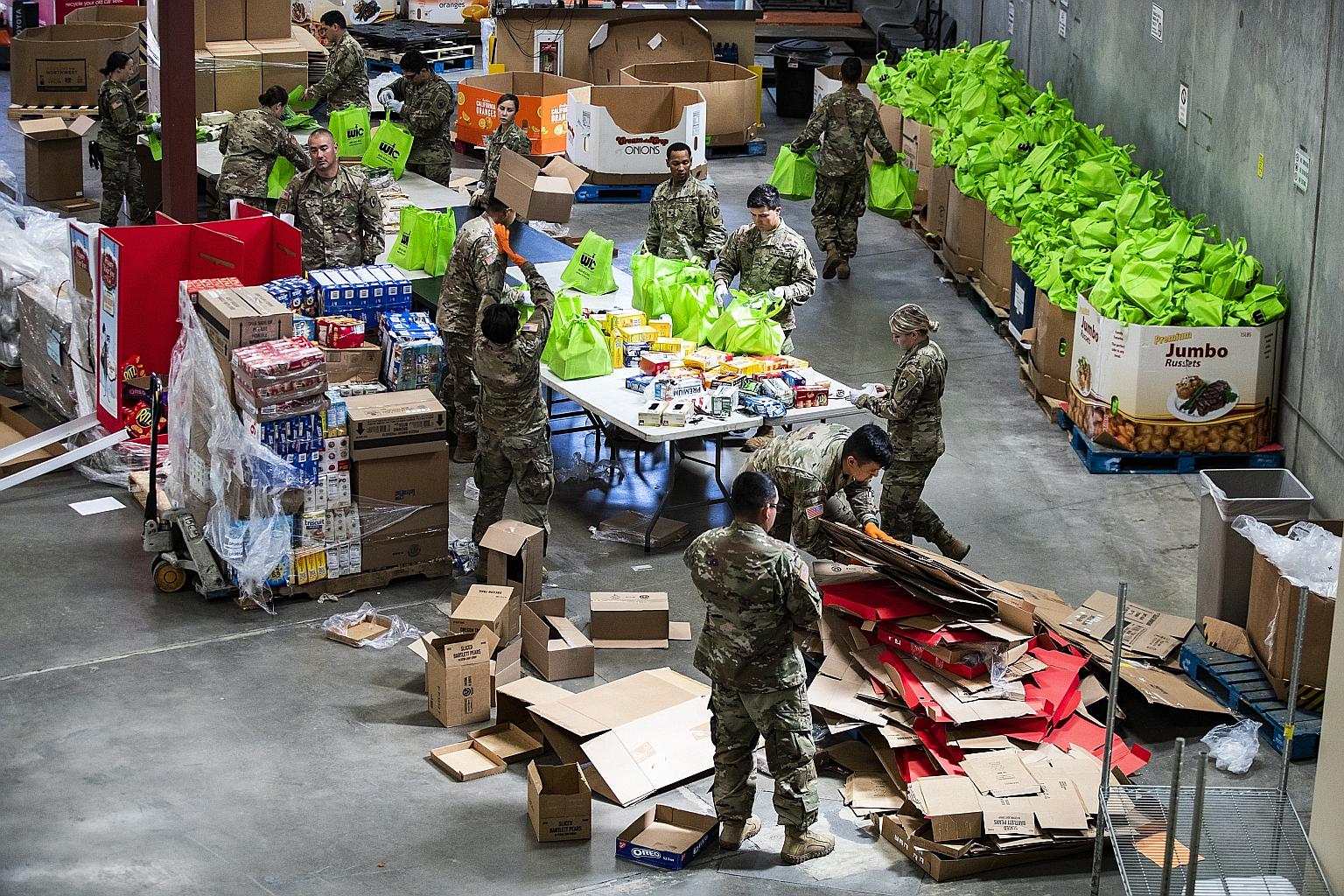Coronavirus pandemic
US finalises historic $2.9 trillion relief package
Plan set to include funds for some households and loans for firms to tide them over pandemic
Sign up now: Get ST's newsletters delivered to your inbox

Soldiers packing donated food into bags that will be delivered to people in need at a food bank in Indio, California. The US' coronavirus relief package is expected to include a one-time direct payment of US$1,200 (S$1,730) per adult and US$500 per child to lower-and middle-income households in the country.
PHOTO: EPA-EFE
Charissa Yong US Correspondent In Washington, Charissa Yong
Follow topic:
The US Senate and the White House yesterday finalised a historic US$2 trillion (S$2.9 trillion) relief package to stimulate the economy and help American workers, small businesses and industries hit hard by the coronavirus pandemic.
"In effect, this is a wartime level of investment into our nation," said Senate Majority Leader Mitch McConnell as he announced the highly anticipated deal, the country's largest action yet to combat the coronavirus, which has infected at least 55,000 Americans and killed more than 780.
The package is expected to include a one-time direct payment of US$1,200 per adult and US$500 per child to lower-and middle-income households.
It will also expand unemployment insurance coverage and payments.
The Bill sets aside around US$350 billion for small business loans and US$500 billion for loans for distressed companies - excluding those owned by President Donald Trump and other top government leaders.
More than US$130 billion will go to hospitals and other healthcare providers, and another US$150 billion in aid to state and local governments, said Senate Minority Leader Chuck Schumer.
The Senate was due to vote yesterday to pass the Bill, which will then go to the President for signing and to the House to be passed.
Mr Trump said on Tuesday that he wanted the US back to normal and reopened for business by Easter on April 12, despite the soaring infection rate in the New York metropolitan area and warnings from public health experts that the worst is yet to come.
"You'll have packed churches all over our country. I think it would be a beautiful time," he said at a Fox News townhall event televised on Tuesday. "I don't want the cure to be worse than the problem itself... you can destroy a country this way, by closing it down."
But he later softened his stance at an evening press briefing by saying "large sections" of the country could be opened up instead of all of it.
"My first priority is always the health and safety of the American people," said Mr Trump.
A growing number of states in the country have closed non-essential businesses and ordered people to stay home, leading to mass layoffs and distressed industries, and bringing much of the economy to a grinding halt.
While the President does not have the last word on policy as states can determine much of their own, easing restrictions by Easter would create risks to the nation's health and markets, said analysts.
Not enough was known on immunity to the coronavirus, infection rates and transmission, and so there was just no way of knowing how successful Mr Trump's preference for targeted measures allowing more economic activity could be, said Eurasia Group analysts in a research note on Tuesday.
Even as the Trump administration weighed the trade-offs in keeping restrictions in place, the World Health Organisation warned that the US had the potential to become the new epicentre of the pandemic owing to the "very large acceleration" in cases.
Top health officials said on Tuesday that they were deeply concerned about the New York hot spot, urging everyone who recently left the metropolitan area to quarantine themselves for 14 days.
More than half, or 56 per cent, of all the new confirmed coronavirus cases in the US are from the New York metropolitan area, and 31 per cent of all US patients who died are from the same region, said White House coronavirus response coordinator Deborah Birx.
About one in 1,000 people in the New York area are infected with the virus, about eight to 10 times higher than in other places, said Mr Anthony Fauci, head of the National Institute of Allergy and Infectious Diseases.
New York state has the highest number of cases in the US by far. It has more than 26,400 confirmed cases and at least 270 deaths, out of the country's more than 55,000 cases and over 780 deaths.
The city of New York is gearing up for an anticipated surge in patients, adding hospital beds and mobile testing sites as Governor Andrew Cuomo warned that the pandemic would peak in the next 14 to 21 days.
While business leaders publicly urged the government to consider lifting some restrictions, experts were alarmed at the prospect of easing off the brakes too early, even as they acknowledged the dilemma that policymakers faced.
Centre for Global Development senior policy fellow Jeremy Konyndyk on Twitter cited recent studies from Harvard University and Imperial College London which used models to project that temporary one-off social distancing measures would delay, and not avert, a surge in cases.
"Lifting those measures before we are ready just puts us back at square one," he said. "What the President is contemplating is truly dangerous. Even now, the situation developing in New York City seems on course to eclipse Wuhan and, potentially, northern Italy.
"Easing off the brakes too early just guarantees more US cities reaching that same point."

